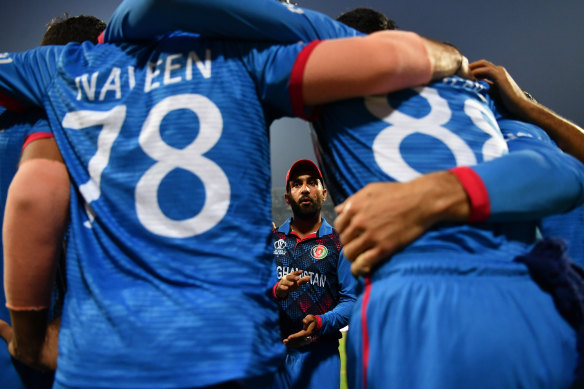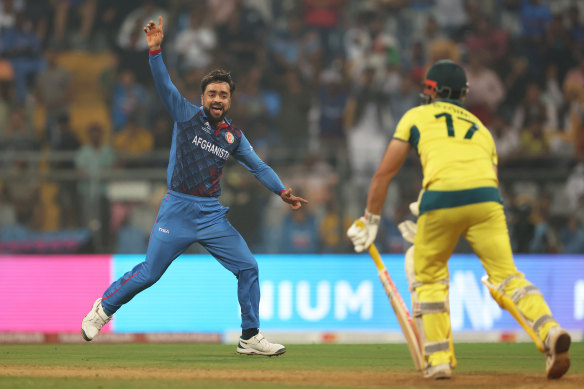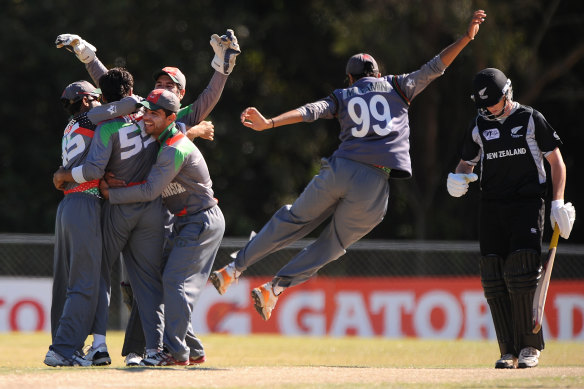This was published 1 year ago
Opinion
This is no time to dismiss Afghanistan’s cricket fairytale
Geoff Lawson
Cricket columnistWhen the pundits cast their well schooled eyes across the form guide for the 2023 World Cup, they surely had hosts India on top followed by defending champions England.
Australia, after underwhelming warm-up series against South Africa and India, were given a chance of scraping into a semi-final along with the Kiwis and Proteas. Pakistan could go undefeated or finish third last. The Netherlands and Afghanistan could raffle for ninth and 10th.
The top of table has been fairly predictable. India have the speed and the spin to confuse all-comers. Whether using a shiny new ball or a bruised pellet, it makes little difference to their penetration. Their batting line-up has quality and depth, and they are playing on pitches they know well.
But even given India’s undoubted spinning strength, they probably still don’t have the best slow bowlers in the tournament. Afghanistan have a guru, a PhD, a masters candidate and an undergraduate headed for a professorship in the mysteries of spin.
Rashid Khan, Mohammad Nabi, Mujeeb Ur Rahman and Noor Ahmad were perceived as four tweakers that would give the Afghans their best chance to trouble the big boys. But where do world-class spinners come from west of the Hindu Kush?
The cricket seed was planted in South Asia by the colonisers from England, who subjugated nations then installed a public service and sports fields. The neighbours over the Khyber Pass made the game their own (an Indian game invented by the British, it is said), but even when the British took over in Afghanistan in 1879 - two years after the first Test match - the Afghan Pashtuns, Tajiks, Balochs et al had no time and less inclination for taking on the mad dogs in the midday sun.

Afghanistan captain Hashmatullah Shahidi rallies his side during the World Cup.Credit: Getty
Since the British invaders were sent on their way in 1919, there have been seven changes to the formative status of Afghanistan. But for the cricket world, the watershed may have been the Soviet Union’s 1979 invasion. When the Australian Test team toured Pakistan in 1980, the only security measure taken for team was that the trip to the Khyber Pass was shortened by 10 kilometres – you could still hear the artillery fire, though.
The Soviets occupied for 10 years and the refugees headed mostly towards Pakistan, through the Khyber Pass or the high valleys of the Hindu Kush, or through Jalalabad to Pashtun Peshawar, or south from Kandahar to Quetta. In Peshawar, Quetta or anywhere else along that fractious border, the locals worked hard, attended the mosque and played cricket. They had a natural talent, a competitive instinct and plenty of willing teachers. When the Soviets were ousted a decade later, many refugees were able to return. Many did not.
The Taliban’s rise in the 1990s changed the picture in Afghanistan again. Contrary to popular opinion, cricket was actually permitted under the first Taliban iteration – for men, at least. But today, with the Taliban again in charge, the national team play under the flag of the previous Islamic Emirate of Afghanistan and not under the Taliban banner.
Complicated? Not half. That part of the planet is rarely straightforward. However, the news on Saturday of the ICC suspending Sri Lanka due to “government interference” begs questions about consistency when dealing with other South Asian authorities.

Star Afghan spinner Rashid Khan.Credit: Getty
Anyhow, the Afghans have taken to the game extraordinarily well and after four victories in India, including a memorable triumph over Pakistan, found themselves pushing for a World Cup semi-final spot. A close-run defeat on Friday night to confirmed semi-finalists South Africa put an end to that dream, but it was a cracking contest between two quality sides. Kenya, under the guidance of Steve Tikolo and the Otieno brothers, remain the only associate nation to reach a World Cup last four, back in 2003.
In a cascade of fascinating events, I became the coach of the Afghan Under-19 team for the 2012 World Cup. My assistants, Ashleigh Byron and Warren Smith, were not at all sure what the standard of the squad would be, but the senior team were getting some promising results at associate level.
In short, the young men did very well in an environment – Queensland – that was quite alien to them, losing the plate final to Sri Lanka but pushing teams like Pakistan and New Zealand. They spoke glowingly of the televised national competition back home, the sponsors supporting the game and the purpose-built stadium in Jalalabad, halfway between Kabul and Peshawar.
I was invited to come and see for myself. Though much tempted, I never made the journey. That is my loss. The junior member of that squad, Hashmatullah Shahidi, is now the national captain. Quiet, respectful and with a titanium resolve, he would take deliveries to the body from the quicks and refuse to show any sign of discomfort. Against Zimbabwe in 2021, he became the first Afghan to make 200 in a Test match.

Afghanistan’s players celebrate after taking a wicket against New Zealand in the 2012 Under-19 World Cup on the Sunshine Coast.Credit: Getty
“Hashie” is the leader of a very impressive batting line-up. The spinners have earned the “handle with care” treatment from opposing batsmen, but Shahidi’s top-order has risen to world-class standard.
Nearly all the Afghan players make their professional living via the T20 caravan, but they have modified their batting and bowling techniques wonderfully for the 50-over game – and great credit must go to coach Jonathan Trott for getting his message successfully across.
Against Australia on Tuesday night they were well on track for their biggest scalp of the tournament and a semi-final berth until Glenn Maxwell played THAT innings. The Afghans didn’t lose – they were beaten by a willow wand and a salix alba spell.
There were signs of shell-shock against the Proteas, but yet another classy dig – this time from Azmat Omarzai – helped them compile a defendable score. They have an aggressive intent with bat and ball which makes them entertaining and watchable, and they never give in – all the traits of top teams.
The challenge for Afghanistan cricket will be in establishing the pathways for the next generation of Rashids, Nabis and Hashmats – and, hopefully, their female players who have sought refuge across the planet given the internationally unrecognised political state of their nation.
Kenyan cricket fell off a cliff when the Otieno dynasty came to an end and there was no one willing to carry the laurels. Maybe the ever-proliferation of T20 tournaments will provide the vehicle for the success of the unlikely cricket nation of Afghanistan. Cricket watchers across the globe have their fingers crossed.
Watch every Australian game plus other big match-ups live and free on Nine, 9Gem and 9Now.
Sports news, results and expert commentary. Sign up for our Sport newsletter.